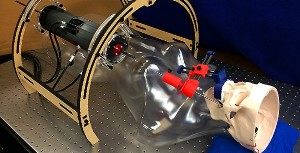For those most severely affected, treating epilepsy means drilling through the skull deep into the brain to destroy the small area where the seizures originate – invasive, dangerous and with a long recovery period.
 Patient mockup of surgical robot designed to treat epilepsy by entering the brain through the cheek. (Laboratory for the Design and Control of Energetic Systems / Vanderbilt)
Patient mockup of surgical robot designed to treat epilepsy by entering the brain through the cheek. (Laboratory for the Design and Control of Energetic Systems / Vanderbilt)
Five years ago, a team of Vanderbilt engineers wondered: Is it possible to address epileptic seizures in a less invasive way? They decided it would be possible. Because the area of the brain involved is the hippocampus, which is located at the bottom of the brain, they could develop a robotic device that pokes through the cheek and enters the brain from underneath which avoids having to drill through the skull and is much closer to the target area.
To do so, however, meant developing a shape-memory alloy needle that can be precisely steered along a curving path and a robotic platform that can operate inside the powerful magnetic field created by an MRI scanner.
The engineers have developed a working prototype, which was unveiled in a live demonstration this week at the Fluid Power Innovation and Research Conference in Nashville by David Comber, the graduate student in mechanical engineering who did much of the design work.
The business end of the device is a 1.14 mm nickel-titanium needle that operates like a mechanical pencil, with concentric tubes, some of which are curved, that allow the tip to follow a curved path into the brain. (Unlike many common metals, nickel-titanium is compatible with MRIs). Using compressed air, a robotic platform controllably steers and advances the needle segments a millimeter at a time.
According to Comber, they have measured the accuracy of the system in the lab and found that it is better than 1.18 mm, which is considered sufficient for such an operation. In addition, the needle is inserted in tiny, millimeter steps so the surgeon can track its position by taking successive MRI scans.
According to Associate Professor of Mechanical Engineering Eric Barth, who headed the project, the next stage in the surgical robot’s development is testing it with cadavers. He estimates it could be in operating rooms within the next decade.
To come up with the design, the team began with capabilities that they already had.
“I’ve done a lot of work in my career on the control of pneumatic systems,” Barth said. “We knew we had this ability to have a robot in the MRI scanner, doing something in a way that other robots could not. Then we thought, ‘What can we do that would have the highest impact?’”
At the same time, Associate Professor of Mechanical Engineering Robert Webster had developed a system of steerable surgical needles. “The idea for this came about when Eric and I were talking in the hallway one day and we figured that his expertise in pneumatics was perfect for the MRI environment and could be combined with the steerable needles I’d been working on,” said Webster.
The engineers identified epilepsy surgery as an ideal, high-impact application through discussions with Associate Professor of Neurological Surgery Joseph Neimat. They learned that currently neuroscientists use the through-the-cheek approach to implant electrodes in the brain to track brain activity and identify the location where the epileptic fits originate. But the straight needles they use can’t reach the source region, so they must drill through the skull and insert the needle used to destroy the misbehaving neurons through the top of the head.
Comber and Barth shadowed Neimat through brain surgeries to understand how their device would work in practice.
“The systems we have now that let us introduce probes into the brain – they deal with straight lines and are only manually guided,” Neimat said. “To have a system with a curved needle and unlimited access would make surgeries minimally invasive. We could do a dramatic surgery with nothing more than a needle stick to the cheek.”
The engineers have designed the system so that much of it can be made using 3-D printing in order to keep the price low. This was achieved by collaborating with Jonathon Slightam and Vito Gervasi at the Milwaukee School of Engineering who specialize in novel applications for additive manufacturing.
Current funding comes through grant 0540834 from the Center for Compact and Efficient Fluid Power, a National Science Foundation Engineering Research Center that supports advances in fluid power, and past funding from Martin Ventures.
Source: http://www.vanderbilt.edu/
Disclaimer: The views expressed here are those of the author expressed in their private capacity and do not necessarily represent the views of AZoM.com Limited T/A AZoNetwork the owner and operator of this website. This disclaimer forms part of the Terms and conditions of use of this website.